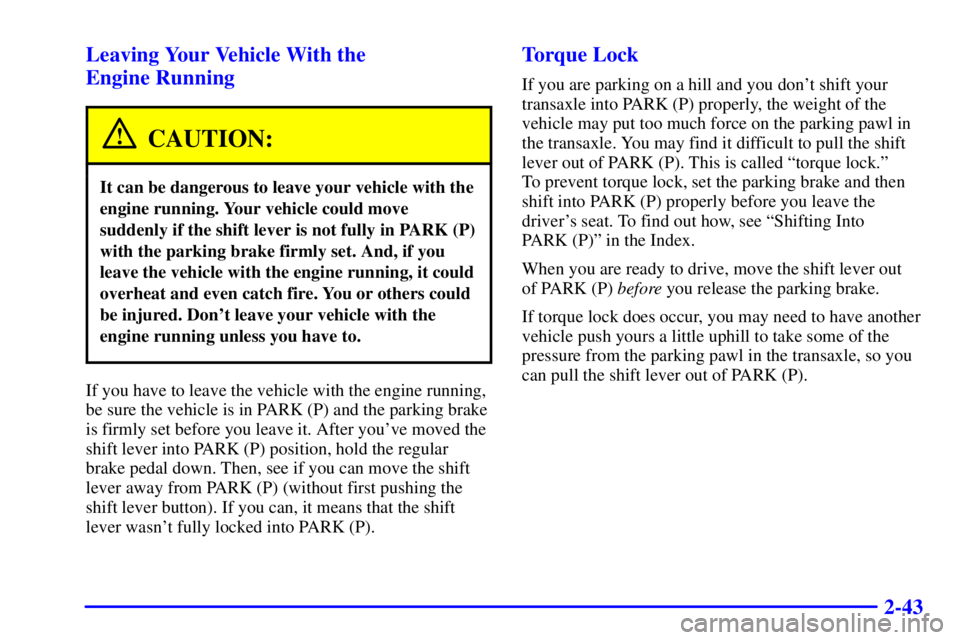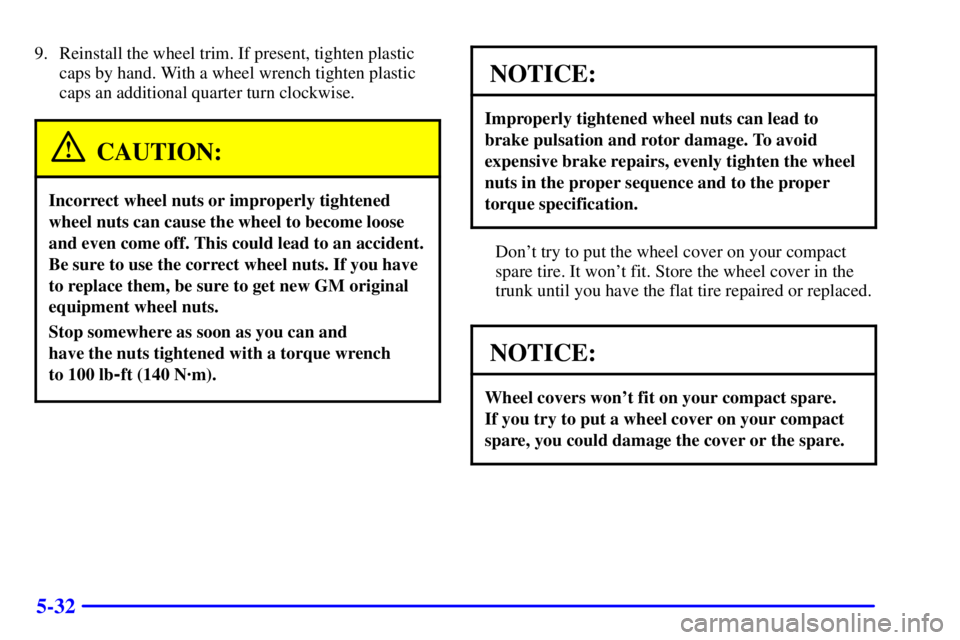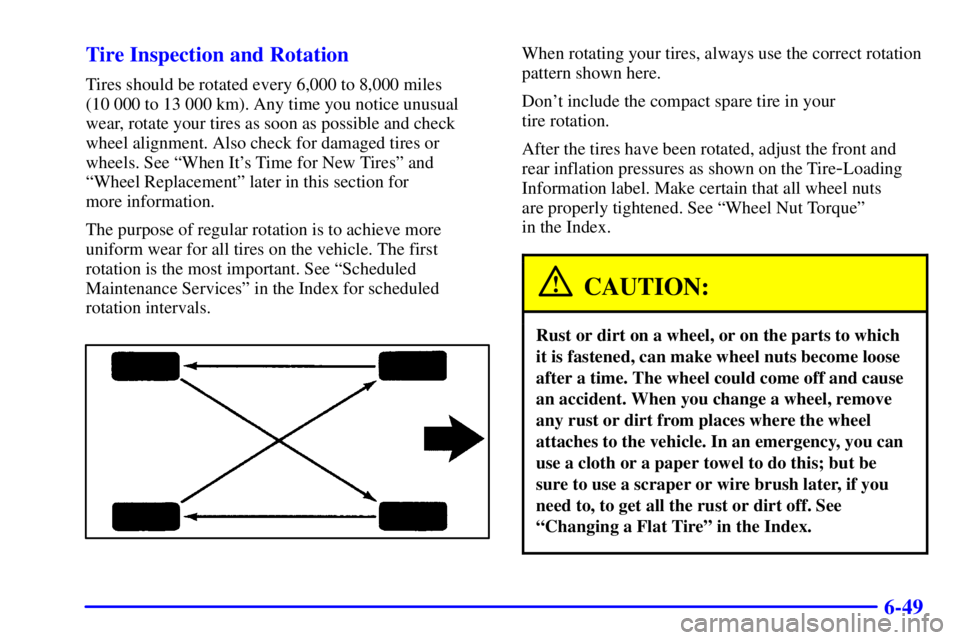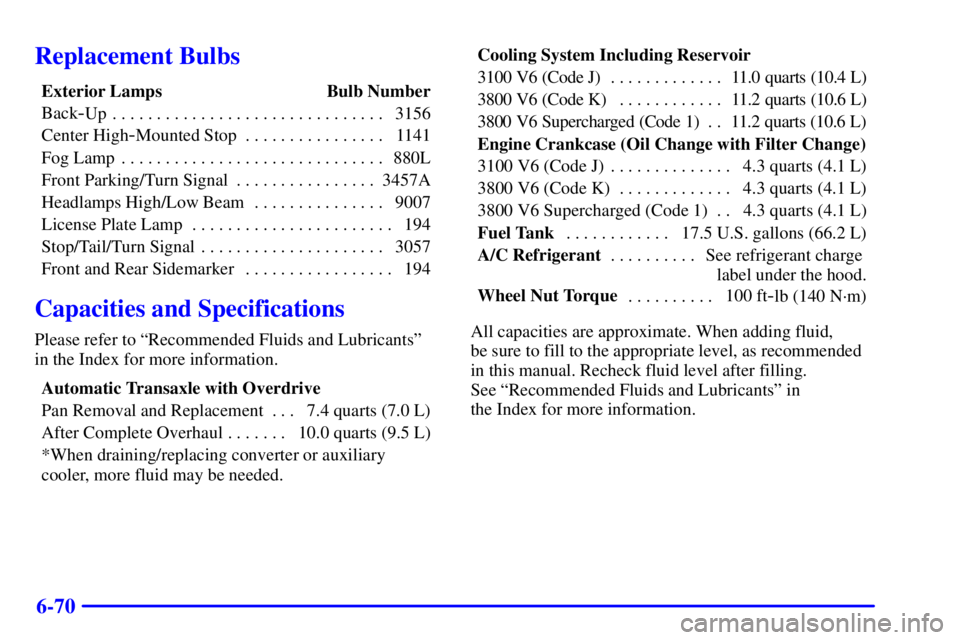2001 PONTIAC GRAND PRIX torque
[x] Cancel search: torquePage 112 of 373

2-43 Leaving Your Vehicle With the
Engine Running
CAUTION:
It can be dangerous to leave your vehicle with the
engine running. Your vehicle could move
suddenly if the shift lever is not fully in PARK (P)
with the parking brake firmly set. And, if you
leave the vehicle with the engine running, it could
overheat and even catch fire. You or others could
be injured. Don't leave your vehicle with the
engine running unless you have to.
If you have to leave the vehicle with the engine running,
be sure the vehicle is in PARK (P) and the parking brake
is firmly set before you leave it. After you've moved the
shift lever into PARK (P) position, hold the regular
brake pedal down. Then, see if you can move the shift
lever away from PARK (P) (without first pushing the
shift lever button). If you can, it means that the shift
lever wasn't fully locked into PARK (P).
Torque Lock
If you are parking on a hill and you don't shift your
transaxle into PARK (P) properly, the weight of the
vehicle may put too much force on the parking pawl in
the transaxle. You may find it difficult to pull the shift
lever out of PARK (P). This is called ªtorque lock.º
To prevent torque lock, set the parking brake and then
shift into PARK (P) properly before you leave the
driver's seat. To find out how, see ªShifting Into
PARK (P)º in the Index.
When you are ready to drive, move the shift lever out
of PARK (P) before you release the parking brake.
If torque lock does occur, you may need to have another
vehicle push yours a little uphill to take some of the
pressure from the parking pawl in the transaxle, so you
can pull the shift lever out of PARK (P).
Page 258 of 373

5-32
9. Reinstall the wheel trim. If present, tighten plastic
caps by hand. With a wheel wrench tighten plastic
caps an additional quarter turn clockwise.
CAUTION:
Incorrect wheel nuts or improperly tightened
wheel nuts can cause the wheel to become loose
and even come off. This could lead to an accident.
Be sure to use the correct wheel nuts. If you have
to replace them, be sure to get new GM original
equipment wheel nuts.
Stop somewhere as soon as you can and
have the nuts tightened with a torque wrench
to 100 lb
-ft (140 N´m).
NOTICE:
Improperly tightened wheel nuts can lead to
brake pulsation and rotor damage. To avoid
expensive brake repairs, evenly tighten the wheel
nuts in the proper sequence and to the proper
torque specification.
Don't try to put the wheel cover on your compact
spare tire. It won't fit. Store the wheel cover in the
trunk until you have the flat tire repaired or replaced.
NOTICE:
Wheel covers won't fit on your compact spare.
If you try to put a wheel cover on your compact
spare, you could damage the cover or the spare.
Page 298 of 373

6-36
NOTICE:
Continuing to drive with worn-out brake pads
could result in costly brake repair.
Some driving conditions or climates may cause a brake
squeal when the brakes are first applied or lightly
applied. This does not mean something is wrong
with your brakes.
Properly torqued wheel nuts are necessary to help prevent
brake pulsation. When tires are rotated, inspect brake
pads for wear and evenly tighten wheel nuts in the
proper sequence to GM torque specifications.
Brake linings should always be replaced as complete
axle sets.
See ªBrake System Inspectionº in Section 7 of this
manual under Part C ªPeriodic Maintenance Inspections.º
Brake Pedal Travel
See your dealer if the brake pedal does not return to
normal height, or if there is a rapid increase in pedal
travel. This could be a sign of brake trouble.
Brake Adjustment
Every time you apply the brakes, with or without the
vehicle moving, your brakes adjust for wear.
Replacing Brake System Parts
The braking system on a vehicle is complex. Its many
parts have to be of top quality and work well together
if the vehicle is to have really good braking. Your
vehicle was designed and tested with top
-quality
GM brake parts. When you replace parts of your braking
system
-- for example, when your brake linings wear
down and you have to have new ones put in
-- be sure
you get new approved GM replacement parts. If you
don't, your brakes may no longer work properly. For
example, if someone puts in brake linings that are wrong
for your vehicle, the balance between your front and
rear brakes can change
-- for the worse. The braking
performance you've come to expect can change in many
other ways if someone puts in the wrong replacement
brake parts.
Page 311 of 373

6-49 Tire Inspection and Rotation
Tires should be rotated every 6,000 to 8,000 miles
(10 000 to 13 000 km). Any time you notice unusual
wear, rotate your tires as soon as possible and check
wheel alignment. Also check for damaged tires or
wheels. See ªWhen It's Time for New Tiresº and
ªWheel Replacementº later in this section for
more information.
The purpose of regular rotation is to achieve more
uniform wear for all tires on the vehicle. The first
rotation is the most important. See ªScheduled
Maintenance Servicesº in the Index for scheduled
rotation intervals.
When rotating your tires, always use the correct rotation
pattern shown here.
Don't include the compact spare tire in your
tire rotation.
After the tires have been rotated, adjust the front and
rear inflation pressures as shown on the Tire
-Loading
Information label. Make certain that all wheel nuts
are properly tightened. See ªWheel Nut Torqueº
in the Index.
CAUTION:
Rust or dirt on a wheel, or on the parts to which
it is fastened, can make wheel nuts become loose
after a time. The wheel could come off and cause
an accident. When you change a wheel, remove
any rust or dirt from places where the wheel
attaches to the vehicle. In an emergency, you can
use a cloth or a paper towel to do this; but be
sure to use a scraper or wire brush later, if you
need to, to get all the rust or dirt off. See
ªChanging a Flat Tireº in the Index.
Page 331 of 373

6-69
Fuse Description
30 Alt Sense
31 Torque Converter Clutch (TCC)
32 Fuel Pump
33 Electronic Control
Module/Powertrain
Control Module
34 Spare
35 Fog Lamps
36 Horn
37 Chime/Mall Module, Taillamps,
Parking Lamps, Sidemarker
Lamps, Dimmable Lamps
38 Spare Fuse
39 Air Pump
40 SpareDiode Description
Air Conditioning Clutch Diode
Relay Description
9 Cooling Fan
10 Cooling Fan 2
11 Ignition Main
12 Cooling Fan 1
13 Air Conditioning Clutch
14 Fuel Pump
15 Fuel Pump Speed Cont
16 Horn
17 Fog Lamp
Page 332 of 373

6-70
Replacement Bulbs
Exterior Lamps Bulb Number
Back
-Up 3156. . . . . . . . . . . . . . . . . . . . . . . . . . . . . . .
Center High
-Mounted Stop 1141. . . . . . . . . . . . . . . .
Fog Lamp 880L. . . . . . . . . . . . . . . . . . . . . . . . . . . . . .
Front Parking/Turn Signal 3457A. . . . . . . . . . . . . . . .
Headlamps High/Low Beam 9007. . . . . . . . . . . . . . .
License Plate Lamp 194. . . . . . . . . . . . . . . . . . . . . . .
Stop/Tail/Turn Signal 3057. . . . . . . . . . . . . . . . . . . . .
Front and Rear Sidemarker 194. . . . . . . . . . . . . . . . .
Capacities and Specifications
Please refer to ªRecommended Fluids and Lubricantsº
in the Index for more information.
Automatic Transaxle with Overdrive
Pan Removal and Replacement 7.4 quarts (7.0 L). . .
After Complete Overhaul 10.0 quarts (9.5 L). . . . . . .
*When draining/replacing converter or auxiliary
cooler, more fluid may be needed.Cooling System Including Reservoir
3100 V6 (Code J) 11.0 quarts (10.4 L). . . . . . . . . . . . .
3800 V6 (Code K) 11.2 quarts (10.6 L). . . . . . . . . . . .
3800 V6 Supercharged (Code 1) 11.2 quarts (10.6 L). .
Engine Crankcase (Oil Change with Filter Change)
3100 V6 (Code J) 4.3 quarts (4.1 L). . . . . . . . . . . . . .
3800 V6 (Code K) 4.3 quarts (4.1 L). . . . . . . . . . . . .
3800 V6 Supercharged (Code 1) 4.3 quarts (4.1 L). .
Fuel Tank17.5 U.S. gallons (66.2 L) . . . . . . . . . . . .
A/C RefrigerantSee refrigerant charge . . . . . . . . . .
label under the hood.
Wheel Nut Torque100 ft
-lb (140 N´m) . . . . . . . . . .
All capacities are approximate. When adding fluid,
be sure to fill to the appropriate level, as recommended
in this manual. Recheck fluid level after filling.
See ªRecommended Fluids and Lubricantsº in
the Index for more information.